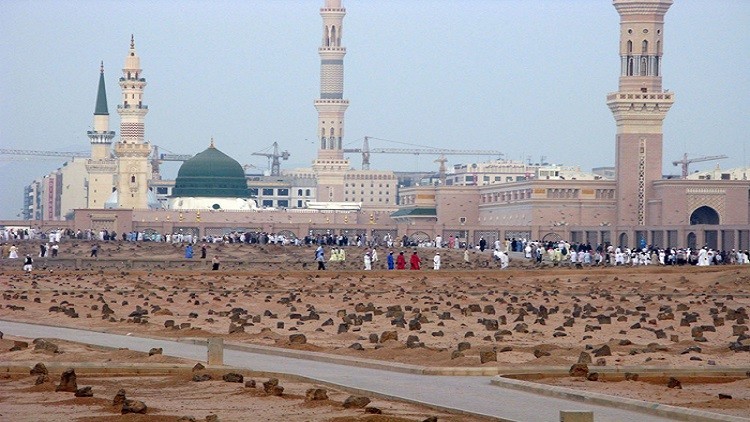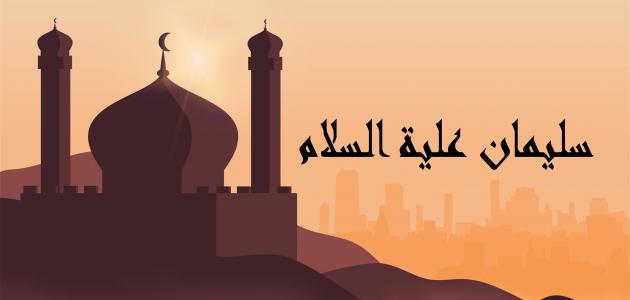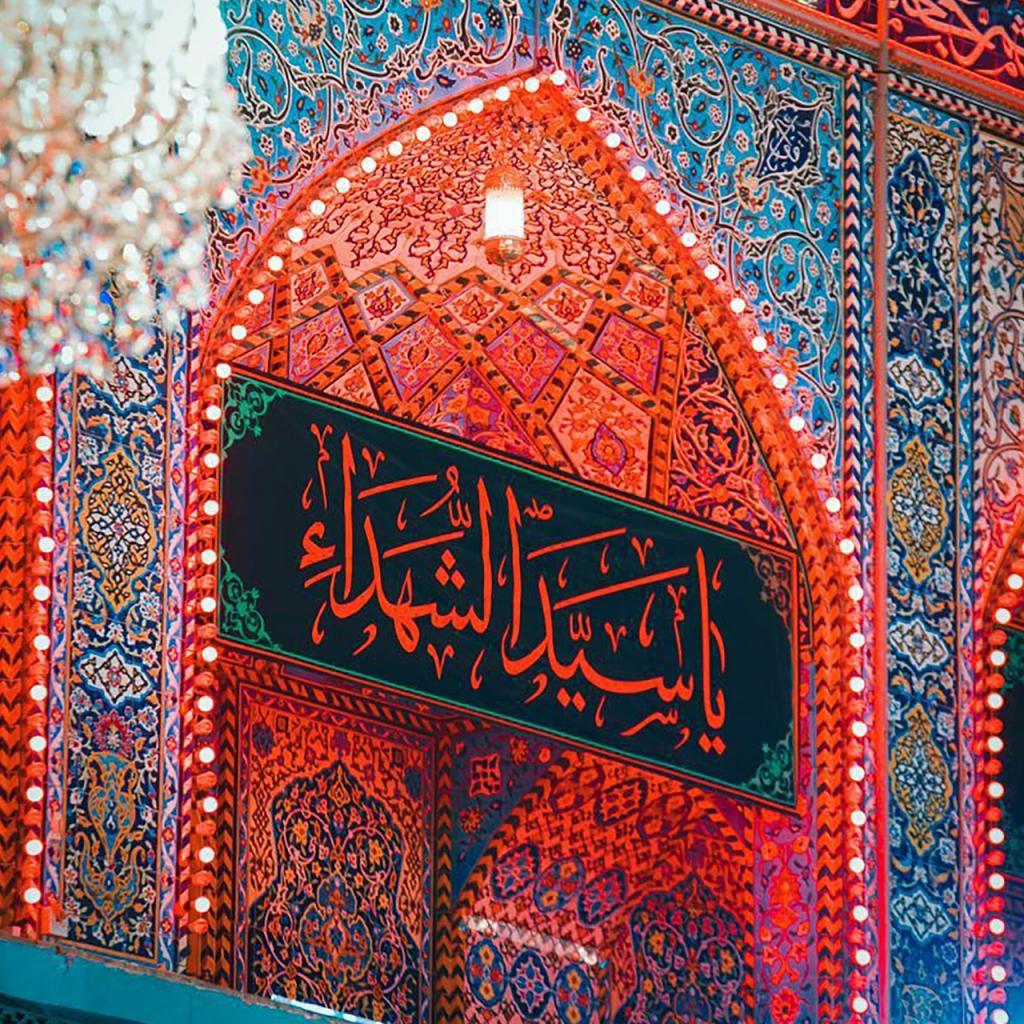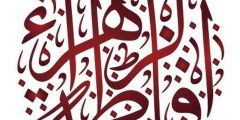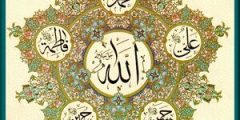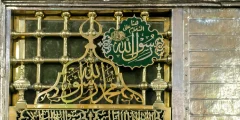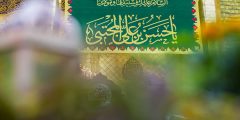Al-Baqi'It is the oldest Muslim cemetery in Medina, next to a tomb Messenger of God (PBUH), and includes four Shiite imams from the family of the Messenger of God (PBUH): Imam Hassan And Imam Ali bin Al-Hussein, Imam Al-Baqir, Imam Al-Sadiq, peace be upon them.
Al-Baqi also includes the grave of Abbas bin Abdul Muttalib, the uncle of the Prophet (PBUH), the grave of Ibrahim bin the Messenger of God, and the grave of a number of the Prophet’s aunts (PBUH), his wives, some of his companions, a number of martyrs of early Islam, and many senior Muslim figures.
Since the time of the Messenger of God (PBUH), Al-Baqi’ has been a shrine for believers to this day, but the Wahhabis demolished the domes there and prevented Muslims from performing their religious rituals and practicing their legitimate beliefs.
Al-Baqi in the language
Al-Baqi’ in language is a place on earth that contains trees of various kinds, and thus Baqi’ Al-Gharqad is called Medina. Because there was a lot of this type of tree, then it was cut down. In the book (Al-Ain), Al-Gharqad: a type of tree.
History of Al-Baqi
There is no historical information or narratives indicating the existence of a cemetery in the name of Al-Baqi’ before Islam. The oldest poetic literary text mentioning Baqi’ Al-Gharqad is by Amr bin Al-Nu’man Al-Baydani, one of the Khazraj leaders, lamenting his people who fought inside a grove in Al-Aqiq ten miles from Medina and Buqi’ Al-Gharqad. He mentioned Ibn al-Atheer wrote in his history of this incident that occurred between the Aws and the Khazraj and called it (the Day of al-Baqi’), and the victory in it was for the Aws. The Jews of Yathrib used to bury their dead in the orchard (Hash Kawkab) near Baqi al-Gharqad. Sheep and camels ate from the herbs found in Al-Baqi.
Read also:The story of Goliath and GoliathAt the beginning of Islam and the time of the Caliphs
When the Messenger of God (PBUH) migrated to Medina and established the Islamic government there, one of the Muslims’ needs was to have a cemetery in which to bury their dead, so he appointed Messenger of God (PBUH) They have the area of Al-Baqi’, and the first of the immigrants to be buried there was Othman bin Mad’un, and among the Ansar was Asaad bin Zurarah. Some historical texts have indicated that this orchard (Al-Baqi’) was not used to bury the dead, but there are immigrants, especially those who built a house for him. In it, - where it was mentioned that the Messenger of God (PBUH) divided the land in order to build homes for the immigrants - and then this house later became the family cemetery, or the burial place of an important person, and one of the most famous of those large houses in Al-Baqi’ is the house of Aqeel bin Abi He demanded, and there were also some small houses, which later became the burial place of their owners, and each tribe chose an area of Al-Baqi’ to bury their dead, so each tribe knew its graves. One of the well-known places in Al-Baqi is the House of Sadness, or the House of Sorrows, built by it Commander of the Faithful To Mrs. ZahraShe used to go to him to cry after the passing of her father, the Messenger of God (may God’s prayers and peace be upon him). There is also the cemetery of Al-Rawha’, which is located in the middle of Al-Baqi’.
It was said that Imam Ali He chose a house next to Aqeel’s house in Al-Baqi’, and he was told: Why are you next to the graves? He said: I found them to be honest neighbors.
There is a designated place in Al-Baqi’ where the funeral is placed before burial. It is called the “funeral place.” It is possible that this place was designated for gathering people or for washing the dead, shrouding him, and performing prayers over him.
Read also:The story of Saeed bin ZaidDuring the time of the Umayyads
The land of Al-Baqi attracted the attention of people during the time of the Umayyads, with the continued expansion of Medina, as some individuals built houses for themselves in it, while continuing to bury the dead. Muhammad bin Al-Hanafiyyah built a house for him in Al-Baqi during the time of Abdul Malik bin Marwan, and he was also buried in Al-Baqi. There are also other houses that were built in that period, including: the house of Ibn Aflah, Muhammad bin Zaid, and Saeed bin Othman, and there was also a house in Al-Baqi’ attributed to Imam Zain Al-Abidin (peace be upon him).
Marwan bin Al-Hakam, the governor of Medina, during the time of Muawiyah, expanded Al-Baqi’ by introducing the orchard (Hash Kawkab) in which Othman was buried in Al-Baqi’, and removed the stone he had placed there. Messenger of God (PBUH) on the grave of Othman bin Mad’un so that he would be known for it, and he placed that stone on the grave of Othman bin Affan.
During the time of the Abbasids
Because of the burial of Abbas bin Abdul Muttalib, the uncle of the Messenger of God (PBUH), in Dar Aqeel, he was also buried Imam Hassan Al-Mujtaba (peace be upon him), Imam Al-Sajjad (peace be upon him), and Imam Al-Baqir (peace be upon him). Bani Abbas expanded and reconstructed the graves of the imams of Al-Baqi (peace be upon him) and transformed Dar Aqeel into a sanctuary, due to their policy that was contrary to the Bani Umayyads on the one hand, and to win the affection of the Alawites, especially the children. Imam Hassan (A) On the other hand. Likewise, Harun al-Rashid, who ruled from 170 AH to 193 AH, reconstructed and expanded the graves of the Imams of al-Baqi’ (peace be upon him).
Historical sources also mentioned the rebuilding of the cemetery of the Imams of al-Baqi’ (peace be upon him) during the time of the Seljuks, where Majd al-Malik al-Balasani al-Qummi (d. 492 AH), the Seljuk minister of Barkiariq (died: 498 AH), sent al-Mimar al-Qummi to rebuild the dome of the Imams of al-Baqi’ (peace be upon him). But when the minister was killed, the Emir of the city killed Al-Mimar after giving him safety.
Read also:The story of Talha bin ObaidullahIbn Jubayr (d. 614 AH) mentioned in his book: Baqi al-Gharqad is located on the eastern side of the city. You exit to it through a door known as “Bab al-Baqi’,” and the first thing you encounter on your left when you exit the aforementioned door is the scene of Safiya, the aunt of the Prophet (PBUH). Then he begins to mention the graves of Al-Baqi’, mentioning the Rawdat of Al-Abbas bin Abdul Muttalib and Al-Hasan bin Ali (peace be upon him), which is a dome high in the air close to the aforementioned gate of Al-Baqi’ and to the right of the one who exits from it, and the head of Al-Hasan (peace be upon him) to the feet of Al-Abbas and their graves are high above the ground, wide and covered with plastered panels. The most beautiful tape is studded with yellow sheets and strung together with its nails, with the most ingenious characteristic and most beautiful appearance. In this shape is the tomb of Ibrahim ibn the Prophet (PBUH). Next to this Abbasid dome is a house of lineage. To Fatima, daughter of the Prophet (PBUH) It is known as the House of Sadness.
Ibn al-Najjar (d. 643 AH) mentioned that in al-Baqi’ there were masters from among the Tabi’in and after them ascetics, scholars, and famous people, but their graves are not known today, except for nine graves: the grave of al-Abbas ibn Abd al-Muttalib, the uncle of the Prophet (may God bless him and grant him peace), and the graves of the imams of al-Baqi’ (peace be upon him). The two graves are in a large, high, ancient dome built at the beginning of Al-Baqi’, and it has two doors, one of which is opened every day for visits, as well as the dome of the grave of Fatima bint Asad, and the dome of the grave of Othman bin Affan.
During the time of the Ilkhanids
After the fall of Baghdad, the capital of the Abbasid state, at the hands of the Mongols, and the departure of the Abbasids to Egypt, to form the Mamluk government in Cairo, during this period of time, Ibn Battuta traveled in the year 725 AH to Mecca and Medina, and mentioned Baqi’ al-Gharqad, and pointed out the presence of the grave of Safiya bint Abd al-Muttalib, his paternal aunt. The Messenger of God (may God’s prayers and peace be upon him) and the mother of Al-Zubayr bin Al-Awwam, and in front of him is the grave of Abu Abdullah Malik bin Anas, with a small dome over it, and in front of him is the grave of Ibrahim bin the Messenger of God (may God bless him and grant him peace), with a white dome over it, and to its right is the grave of Abdul Rahman bin Omar bin Al-Khattab, known as Abu Shahma, and next to it is a grave. Aqeel bin Abi Talib, and the grave of Abdullah bin Jaafar bin Abi Talib, and next to them are the graves of the Mothers of the Believers, followed by a garden containing the grave of Abbas bin Abdul Muttalib, his uncle. Messenger of God (PBUH) and the grave of Al-Hasan bin Ali (peace be upon him), which is a lofty dome and their graves are wide and studded with yellow sheets. At the end of Al-Baqi’ is the grave of Othman bin Affan and Fatima bint Asad. Likewise in Al-Baqi’ are the graves of the Muhajireen, the Ansar and the rest of the Companions, but most of them are not known.
In the time of the Ottomans
In the year 1220 AH, the Wahhabis besieged Medina, and demolished the domes in Al-Baqi’, except for the dome of the Messenger of God (PBUH), by order of Saud bin Abdul Aziz. Sultan Mahmoud II Al-Othmani sent an army to the city to fight the Wahhabis, and the army was able to expel them in the year 1227 AH. This historical event was called (cutting off the roots of the Kharijites).
In his book Travels in the Arabian Peninsula, John Lewis Burckhardt mentioned a journey that took place on Safar 3, 1230, to the Hijaz, Mecca, and Medina. He gave a comprehensive description of Al-Baqi’ after the destruction caused by the Wahhabism. He mentioned that all the graves had been destroyed, and there were no inscriptions or writings on them. Except for piles of clay, and nothing was spared from Wahhabi vandalism except the remains of domes and small buildings.
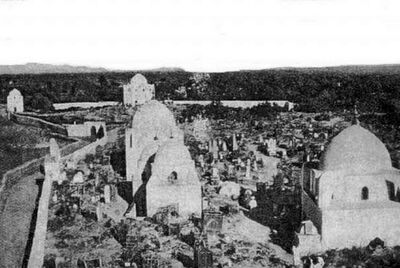
at present
The Al Saud government expanded Al-Baqi', and as the years progressed, it placed an iron fence around the cemetery.
Building graves and domes in Al-Baqi’
The issue of burying the dead Muslims and religious figures in Al-Baqi’ and the extreme care given to Muslims and their emphasis on the desirability of visiting the graves of the righteous and believers led to the construction of shrines, domes and buildings over these graves. From that, it is possible to point to the grave of Abbas bin Abdul Muttalib, may God have mercy on him. Prophet (PBUH), and four Shiite imams, as well as other figures from Bani Hashem And the relatives of the Prophet, the Companions, the scholars, and the Muslim elite throughout history. Domes were built over the graves and shrines were placed over them, where tourists visited them. Documented news was reported in books and sources. The traveler Ibn Battuta, in the first half of the eighth century AH, described Al-Baqi’:
- Baqi al-Gharqad is located to the east of Medina...[and it contains] the tomb of Malik ibn Anas, with a small dome of brief construction, and in front of it is the tomb of the pure, holy, and honorable lineage of the Prophet, Ibrahim ibn the Messenger of God (may God bless him and grant him peace), with a white dome over it...and a garden containing the grave of Abbas ibn Abdul Muttalib, the uncle of the Messenger of God, and the grave of Al-Hassan bin Ali bin Abi Talib (peace be upon him) It is a dome rising in the air, with wonderful rulings, to the right of the one who exits from Bab Al-Baqi and the head of Al-Hasan to the feet of Al-Abbas (peace be upon him), and their graves are high above the ground, wide, covered with wonderfully sticky panels studded with sheets of scratch.
Al-Safadi also talked about domes for the graves of four Shiite imams, and Al-Abbas, the uncle of the Prophet (PBUH).
As for Burckhardt, who made a trip to Medina after Wahhabism came to power, he pointed out that Al-Baqi’ had become one of the most despicable cemeteries in the East at that time, and the Al-Baqi’ Cemetery - like the Hamzah Cemetery in Uhud or the Quba Mosque, the first mosque in Islam - is considered one of the neighborhoods located in the suburb of Medina and from... Holy places. Pilgrims may visit them and consider visiting them as part of their acts of worship.
Farhad Mirza, one of the Qajar princes in the year 1293 A.D., and Muhammad Hussein Khan Farahani in the year 1303 A.D. This is how they describe Al-Baqi’: Al-Baqi’ includes several spots, including a spot for the graves of four of the Imams (peace be upon him) and Abbas, the Prophet’s uncle, and a grave attributed to Lady Al-Zahra (peace be upon her) It also has an embroidered curtain gifted by Sultan Ahmed Al-Othmani in the year 1311 AH, and a spot for the graves of the daughters of the Great Prophet (PBUH), and a spot for his wives (PBUH), and there are other spots.
Demolishing graves
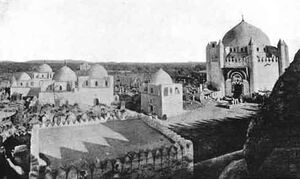
Demolishing the graves of the imams of Al-Baqi is an operation carried out by the Wahhabis and the rulers of the Al Saud family when they took control of Medina. They violated its sanctities and vandalized and demolished its monuments. This process was repeated twice, the first: in the year 1220 AH and the second: in the year 1344 AH.
The demolition of the graves of Al-Baqi’ sparked a number of protests in Islamic countries, including Iran, where the Shiites hold mourning gatherings on this anniversary, give speeches, and remind people of this incident, so much so that it is called the Day of Demolition.
Muslim scholars have written books responding to Wahhabi claims about demolishing graves, including the book Revealing Mistrust.
Some of those buried in Al-Baqi'
A number of prominent Muslims and their historical, religious and political figures were buried in Al-Baqi’ Al-Gharqad, led by four of the imams of Ahl al-Bayt (peace be upon them), in addition to some of the children of the Prophet. Prophet (PBUH) His wives and best companions, and it was said that ten thousand companions were buried in it.
It is likely that the grave of Al-Siddiqah Al-Tahira is located in Al-Baqi Fatima Alzahraa Girl Messenger of God She was buried at night and her grave site was destroyed.
It is also possible that the grave of al-Muhsin al-Saqt ibn al-Muhsin al-Saqt is located in al-Baqi’ Ali bin Abi Talib He was killed as a fetus in the womb of his mother, Fatima Al-Zahra (peace be upon her).
- Imam Al-Hassan Al-Mujtaba (peace be upon him)
- Imam Zain Al-Abidin (peace be upon him)
- Imam Muhammad Al-Baqir (peace be upon him)
- Imam Jaafar Al-Sadiq (peace be upon him)
- Fatima Alzahraa Probably the daughter of the Messenger of God, as her grave is unknown
- Ibrahim bin the Prophet
- Al-Abbas bin Abdul Muttalib, uncle of the Messenger of God (PBUH)
- Muhammad ibn al-Hanafiyyah ibn Ali ibn Abi Talib (peace be upon him)
- Al-Hassan bin Al-Hassan (peace be upon him)
- Aqeel bin Abi Talib, brother of the Commander of the Faithful (peace be upon him)
- Abdullah bin Jaafar bin Abi Talib (peace be upon him)
- Ismail bin Imam Al-Sadiq (peace be upon him)
- Mohsen Al-Saqat is the son of Imam, Commander of the Faithful (peace be upon him), as his grave is unknown
- Muhammad bin Zaid bin Ali bin Al-Hussein bin Abi Talib (peace be upon him)
- Al-Hussein bin Ali bin Al-Hussein (peace be upon him)
- Abdullah / one of the grandchildren of Imam Hassan Al-Mujtaba (peace be upon him)
- Muhammad Al-Nafs Al-Zakia / According to a saying
- Some of the children of Imam Al-Sajjad (peace be upon him)
- Some of the children of Imam al-Baqir (peace be upon him)
- Some of the children of Imam Al-Sadiq (peace be upon him)
- Some of the children of Imam Al-Kadhim (peace be upon him)
- Fatima bint Asad, mother of Imam, Commander of the Faithful (peace be upon him)
- Fatima Umm al-Banin, wife of Imam Commander of the Faithful (peace be upon him)
- Ruqayyah, daughter of the Messenger of God (PBUH)
- Zainab, daughter of the Messenger of God (PBUH)
- Umm Kulthum, daughter of the Messenger of God (PBUH)
- Safiyya bint Abdul Muttalib, aunt of the Messenger of God (PBUH)
- Atika bint Abdul Muttalib, aunt of the Messenger of God (PBUH)
- Jumana bint Abdul Muttalib, aunt of the Messenger of God (PBUH), according to a saying
- Zainab, daughter of Imam, Commander of the Faithful (peace be upon him)
- Umm Salamah, wife of the Messenger of God (PBUH)
- Maria Al-Qibtiyya, wife of the Messenger of God (PBUH)
- Umm Habiba, wife of the Messenger of God (PBUH)
- Zainab, wife of the Messenger of God (PBUH)
- Safiyya, wife of the Messenger of God (PBUH)
- Maimuna, wife of the Messenger of God (PBUH)
- Rehana, wife of the Messenger of God (PBUH)
- Sawda, wife of the Messenger of God (PBUH)
- Juwayriyah, wife of the Messenger of God (PBUH)
- Aisha, wife of the Messenger of God (PBUH)
- Hafsa, wife of the Messenger of God (PBUH)
- Halima Al-Saadia, wet nurse of the Messenger of God (PBUH)
- Othman bin Mazun
- Miqdad bin Al-Aswad
- Jabir bin Abdullah Ansari
- Owner of Ashtar
- Abdullah bin Masood
- Some martyrs of Uhud
- Martyrs of the Hurra incident
- A collection of companions and followers
- A gathering of Muslims and believers
One of the shrines of Al-Baqi’ was the House of Sorrows, according to some historical accounts.
Footnotes
- Kitab al-Ain, vol. 1, p. 184, article on spots.
- Kitab Al-Ayn, vol. 4, p. 458, Gharqad article.
- Al-Hamawi, Dictionary of Countries, vol. 1, 473.
- Ibn Hajar Al-Asqalani, Al-Asaba, vol. 4, p. 575; Ibn Saad, Al-Tabaqat Al-Kubra, vol. 6, p. 92.
- Ibn al-Atheer, Al-Kamil fi al-Tarikh, vol. 1, p. 673.
- Ibn Abi Al-Hadid, Sharh Nahj Al-Balagha, vol. 10, p. 6.
- Ibn Saad, Al-Tabaqat Al-Kubra, vol. 3, p. 101.
- Ibn Saad, Al-Tabaqat Al-Kubra, vol. 3, p. 303.
- Ibn Saad, Al-Tabaqat Al-Kubra, vol. 3, p. 459.
- Najmi, History of the Sanctuary of Imams, p. 65.
- Ibn Saad, Al-Tabaqat Al-Kubra, vol. 4, p. 33.
- Al-Samhudi, Wafaa Al-Wafa, vol. 3, p. 83.
- Al-Samhudi, Wafaa Al-Wafa, vol. 3, p. 101.
- Ibn Saad, Al-Tabaqat Al-Kubra, vol. 4, p. 33.
- Al-Muttaqi Al-Hindi, Kanz Al-Ummal, vol. 15, p. 759.
- Ibn Saad, Al-Tabaqat Al-Kubra, vol. 5, p. 469, vol. 8, p. 68.
- Ibn Shibah, History of Medina, vol. 1, p. 17.
- Al-Samhudi, Wafa’ al-Wafa’, vol. 3, p. 84; Ibn Saad, Al-Tabaqat Al-Kubra, vol. 5, p. 83.
- Ibn Saad, Al-Tabaqat Al-Kubra, vol. 5, p. 87.
- Al-Tabari, History of Al-Tabari, vol. 7, p. 587.
- Al-Samhudi, Wafaa Al-Wafa, vol. 3, pp. 83-84.
- Al-Samhudi, Wafaa Al-Wafa, vol. 3, p. 103.
- Ibn Al-Najjar, Al-Durra Al-Thamina’, p. 168.
- Al-Samhudi, Wafaa Al-Wafa, vol. 3, pp. 83-84.
- Ibn Shibah, History of Medina, vol. 1, p. 127.
- Ibn Shibah, History of Medina, vol. 1, p. 111.
- Ibn Al-Najjar, Al-Durra Al-Thamina’, p. 166.
- Najmi, History of the Sanctuary of Imams, p. 86.
- Najmi, History of the Sanctuary of Imams, p. 88.
- Ibn al-Atheer, Al-Kamil fi al-Tarikh, vol. 10, p. 352.
- Ibn Jubayr, The Journey of Ibn Jubayr, p. 174.
- Ibn Al-Najjar, Al-Durra Al-Thamina’, p. 166.
- Ibn Al-Najjar, Al-Durra Al-Thamina’, p. 168.
- Ibn Battuta, The Journey of Ibn Battuta, pp. 75-76.
- Ghalib, from Akhbar al-Hijaz and Najd, p. 104.
- Al-Amin, Revealing Suspicion, p. 38.
- Burckhardt, Travels in Arabia, vol. 2, p. 144.
- Ibn Battuta, The Journey of Ibn Battuta, p. 119.
Notes
- Where are those whom I knew in bliss between Al-Aqiq and Baqi Al-Gharqad?
- Ibn Shibah says: Al-Abbas bin Abdul Muttalib was buried at the grave of Fatima bint Asad bin Hashim in the first of the Bani Hashim cemeteries, which is in Dar Aqeel.
References
- ↑
- Ibn Abi Al-Hadid, Abdul Hamid bin Hebatullah, Explanation of Nahj Al-Balagha, edited by: Muhammad Abu Al-Fadl Ibrahim, Beirut, Dar Al-Kutub Al-Arabiyya, 1378 AH.
- Ibn al-Atheer, Ali bin Muhammad, The Lion of the Jungle in the Knowledge of the Companions, Beirut, Dar Al-Fikr, 1409 AH/1989 AD.
- Ibn al-Atheer, Ali bin Muhammad, al-Kamil fi al-Tarikh, Beirut, Dar Sader, 1385 AH/1965 AD.
- Ibn Al-Najjar, Muhammad bin Mahmoud, Al-Durra Al-Thamina fi Akhbar Al-Madina, Beirut, Dar Al-Arqam bin Abi Al-Arqam, d. T.
- Ibn Battuta, Muhammad bin Abdullah, The Journey of Ibn Battuta, Cairo, Al-Azhari Press, 1st edition, 1346 AH.
- Ibn Jubayr, Muhammad bin Ahmad, The Journey of Ibn Jubayr, Beirut, Dar Beirut, 1st edition, d.t.
- Ibn Hajar Al-Asqalani, Ahmed bin Ali, Al-Isaba fi Tamayyis Al-Sahaba, edited by: Adel Ahmed Abdel-Mawjoud, Beirut, Dar Al-Kutub Al-Ilmiyyah, 1st edition, 1415 AH.
- Ibn Saad, Muhammad bin Saad, Al-Tabaqat Al-Kubra, edited by: Muhammad Abdul Qadir Atta, Beirut, Dar Al-Kutub Al-Ilmiyyah, 1st edition, 1410 AH / 1990 AD.
- Ibn Shibah, Omar bin Ubaida, History of the City, edited by: Fahim Muhammad Shaltout, Jeddah, D.N., D.T.
- Ibn Abd al-Barr, Yusef bin Abdullah, Absorption in the Knowledge of Companions, edited by: Ali Muhammad al-Bajjawi, Beirut, Dar al-Jeel, 1st edition, 1412 AH/1992 AD.
- Ibn Qutaybah, Abdullah bin Muslim, Al-Ma’arif, edited by: Tharwat Okasha, Cairo, Egyptian General Book Authority, 2nd edition, 1992 AD.
- Al-Amin, Mohsen, Kashf Al-Irtiba, Qom, Dar Al-Kitab Al-Islamiya, 2nd edition, 1428 AH / 2007 AD.
- Al-Hamawi, Yaqut bin Abdullah, Mu’jam al-Buldan, Beirut, Dar Sader, 2nd edition, 1995 AD.
- Al-Samhoudi, Ali bin Ahmed, Wafaa Al-Wafa Akhbar Dar Al-Mustafa, Beirut, Dar Al-Kutub Al-Ilmiyyah, 1st edition, 1419 AH.
- Al-Tabari, Muhammad bin Jarir, History of Al-Tabari, edited by: Muhammad Abu Al-Fadl Ibrahim, Beirut, Dar Ihya’ al-Tarath al-Arabi, 2nd edition, 1387 AH/1967 AD.
- Al-Farahidi, Al-Khalil bin Ahmed, Al-Ain, Qom, Dar Al-Hijra Foundation, 1409 AH.
- Al-Muttaqi Al-Hindi, Imad Al-Din Ali, Kanz Al-Ummal fi Sunan Al-Qalawal wa Al-A’il, Beirut, Al-Resala Foundation, 5th edition, 1401 AH / 1981 AD.
- Burckhardt, John Lewis, Travels in the Arabian Peninsula, translated and presented by: Sabri Muhammad Hassan, Cairo, National Center for Translation, 1st edition, 2007 AD.
- Ghaleb, Muhammad Adeeb, from Akhbar Al-Hijaz and Najd, D. M., Dar Al-Yamamah, 1395 AH.
- Farhad Mirza Qajar, Safarnama Farhad Mirza Motameddawla, Tehran, printed by Ismail Nawab Safa, 1366 AH.
- Farahani, Muhammad Husayn ibn Mahdi, Safarnama (Journey) Mirza Muhammad Husayn Husayni Farahani, Tehran, printed by Masoud Golzari, 1362 AH.
- Najmi, Muhammad Sadiq, History of the Sanctuary of the Imams of Baqi (peace be upon him), Tehran, Mash’ar, D.T.
